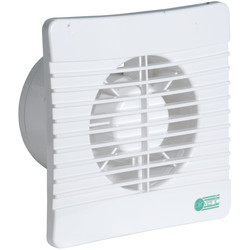This is only kinda plumbing, and very basic - I do apologise for that.
I have a wall-mounted 10cm timer extractor fan in an upstairs bathroom. In the trio of storms we had a couple of years ago the driving rain must have come inside as water marks have appeared all over the wall, and remained - I'm talking a good year or so ago since noticed - I've kept an eye on it and they've not gotten worse, so I don't think it's any other issue (we've had an easier time of it weather-wise since then).
So I have used CoverStain and redone the wall so it looks nice, that meant I took the fan off - it's a straight run of duct to the outside where there is a flat cover with a fly-guard on it.
I see no reason why driving rain could not come in through this entry point again and ruin all my good work. I think I have a few options and I wanted to run it by folk with opinions on what's the best way to make me future less worrisome...
1) Fit an external duct cover that has one of those cowls, that aim downwards and are designed to stop rain ingress (access is difficult from the outside)
2) Get a replacement fan with some kind of integrated shuttering system (but is that mainly for air / odour and not water?)
3) Get some kind of retro-fit backdraft shutter (same question as above, but a very cheap 'fix' if it would work)
For 3) I've seen these flaps for sale (https://www.tlc-direct.co.uk/Products/BG4BS.html) but they do appear to be designed to sit inbetween two runs of duct (hence "in-line" I suppose), and join them, there's a ridge mid-way especially for this. My question is - does a product exist that just sits inside an existing run of duct? Or do you just buy it and sand the ridge off so it slides down the duct? The obvious advantage here - if it works - is that I can do the work from the inside and access won't be a problem. But there's no point doing it if it won't work.
So... at the end of the day, is 1) the best long-term option?
Or can I just shove a piece of plastic or metal down there, shaped as a shallow semi-circle to act as a kind of dam if any small amount of water makes its way in there? Guess it'll just go back out down the external wall then... not something you desire... but the rain was there anyway and better than the internal wall.
I have a wall-mounted 10cm timer extractor fan in an upstairs bathroom. In the trio of storms we had a couple of years ago the driving rain must have come inside as water marks have appeared all over the wall, and remained - I'm talking a good year or so ago since noticed - I've kept an eye on it and they've not gotten worse, so I don't think it's any other issue (we've had an easier time of it weather-wise since then).
So I have used CoverStain and redone the wall so it looks nice, that meant I took the fan off - it's a straight run of duct to the outside where there is a flat cover with a fly-guard on it.
I see no reason why driving rain could not come in through this entry point again and ruin all my good work. I think I have a few options and I wanted to run it by folk with opinions on what's the best way to make me future less worrisome...
1) Fit an external duct cover that has one of those cowls, that aim downwards and are designed to stop rain ingress (access is difficult from the outside)
2) Get a replacement fan with some kind of integrated shuttering system (but is that mainly for air / odour and not water?)
3) Get some kind of retro-fit backdraft shutter (same question as above, but a very cheap 'fix' if it would work)
For 3) I've seen these flaps for sale (https://www.tlc-direct.co.uk/Products/BG4BS.html) but they do appear to be designed to sit inbetween two runs of duct (hence "in-line" I suppose), and join them, there's a ridge mid-way especially for this. My question is - does a product exist that just sits inside an existing run of duct? Or do you just buy it and sand the ridge off so it slides down the duct? The obvious advantage here - if it works - is that I can do the work from the inside and access won't be a problem. But there's no point doing it if it won't work.
So... at the end of the day, is 1) the best long-term option?
Or can I just shove a piece of plastic or metal down there, shaped as a shallow semi-circle to act as a kind of dam if any small amount of water makes its way in there? Guess it'll just go back out down the external wall then... not something you desire... but the rain was there anyway and better than the internal wall.


